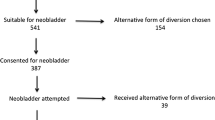Abstract
Purpose
Radical cystectomy (RC) and urinary diversion in the treatment of muscle-invasive bladder cancer is associated with peri-operative complication rates as high as 60%. Ureteroenteric anastomotic stricture (UEAS) is a potential source significant morbidity often requiring secondary interventions. We sought to evaluate our experience with benign UEAS in our open ileal orthotopic neobladder (ON) population.
Methods
After Internal Review Board (IRB) approval, we performed a retrospective review of patients who had RC and ON between 2000 and 2015 at MD Anderson Cancer Center and had at least 6 months of follow-up. Baseline demographics and treatment characteristics, peri-operative and post-operative outcomes, as well as information regarding anastomosis technique and suture types were evaluated. Patients with malignant ureteral obstruction were excluded from the analysis.
Results
418 patients had ON creation and the mean age was 59 years (SD 9.4 years) and 90% were males. The mean follow-up was 57 months (6–183 months). 37 patients (8.9%) developed UEAS in 42 renal units and the mean time to diagnosis was 15.8 months (0.85–90 months). Anastomosis and suture type were not predictive of UEAS (p = 0.594, p = 0.586). Perioperative UTI within 30 days of surgery, and recurrent UTI were predictive of UEAS, HR 2.4 p = 0.03, HR 5.1 p < 0.001, respectively.
Conclusions
UEAS are associated with potentially significant morbidity following ON creation. UEAS may occur early following ON, but may occur as late as 7 years following surgery. Indeed, technical factors and surgeon experience contribute to the rates of UEAS, but perioperative UTI appears to herald future stricture development.

Similar content being viewed by others
References
Chang SS, Bochner BH, Chou R, Dreicer R, Kamat AM, Lerner SP, Lotan Y, Meeks JJ, Michalski JM, Morgan TM, Quale DZ, Rosenberg JE, Zeitman AL, Holzbeierlein JM (2017) Treatment of non-metastatic muscle invasive bladder cancer: AUA/ASCO/ASTRO/SUO guideline. J Urol 198:552–559
Large MC, Cohn JA, Kiriluk KJ, Dangle P, Richards KA, Smith ND, Steinberg GD (2013) The impact of running versus interrupted anastomosis on ureterointestinal stricture rate after radical cystectomy. J Urol 190:923–927
Shabsigh A, Korets R, Vora Brooks CM, Cronin AM, Savage C, Raj G, Bochner B, Dalbagni G, Herr HW, Donat SM (2009) Defining early morbidity of radical cystectomy for patients with bladder cancer using a standardized reporting methodology. Eur Urol 55:164–174
Hautmann RE, dePetriconi RC, Volkmer BG (2011) 25 years of experience with 1000 neobladders:long-term complications. J Urol 185:2207–2212
Studer UE, Burkhard FC, Schumacher M, Kessler TM, Thoeny H, Fleischmann A, Thalmann GN (2006) Twenty years experience with ileal orthotopic low-pressure bladder substitute—lessons to be learned. J Urol 176:161–166
Hautmann RE, de Petriconi R, Kahlmeyer A, Enders M, Volkmer B (2017) Preoperative dilated ureters are a specific risk factor for the development of ureteroenteric strictures after open radical cystectomy and ileal neobladder. J Urol 198:1098–1106
Pantuck AJ, Han KR, Perrotti M, Weiss RE, Cummings KB (2000) Ureteroenteric anastomosis in continence urinary diversion: long-term results and complications of direct versus non-refluxing techniques. J Urol 163:450–455
Shah SH, Movassaghi K, Skinner D, Dalag L, Miranda G, Cai J, Schuckman A, Daneshmand S, Djaladat (2015) Ureteroenteric strictures after open radical cystectomy and urinary diversion: The University of Southern California Experience. Urology 86:87–91
Furrer MA, Roth B, Kiss B, Nguyen DP, Boxler S, Burkhard FC, Thalmass GN, Studer UE (2016) Patients with an orthotopic low pressure bladder substitute enjoy long-term good function. J Urol 196:1172–1180
Anderson CB, Morgan TM, Kappa S, Moore D, Clark PE, Davis R, Penson DF, Barocas DA, Smith JA Jr, Cookson MS, Chang SS (2013) Ureteroenteric anastomotic strictures after radical cystectomy—does operative approach matter? J Urol 189:541–547
Richards KA, Cohn JA, Large MC, Bales GT, Smith ND, Steinberg GD (2015) The effect of length of ureteral resection on benign ureterointestinal stricture rate in ileal conduit or ileal neobladder urinary diversion following radical cystectomy. Urol Onol 33:65.c1–65.c8
Ahmadi N, Ashrafi AN, Hartman N, Shakir A, Cacciamani GE, Freitas D, Rajarubendra N, Fay C, Berger A, Desai MM, Gill IS, Aron M (2019) Use of indocyanine green to minimize uretero-enteris strictures after robotic radical cystectomy. BJU Int 124:302–307
Shen JK, Jamnagerwalla J, Yuh BE, Bassett MR, Chenam A, Warner JN, Zhumkhawala A, Yamzon JL, Whelan C, Ruel NH, Lau CS, Chan KG (2019) Real-time indocyanine green angiography with the SPY fluorescence imaging platform decreases benign ureteroenteric strictures in urinary diversions performed during radical cystectomy. Ther Adv Urol 11:1–7
Author information
Authors and Affiliations
Contributions
CR Benson: Data collection and analysis, manuscript writing. D Ajay: Data Analysis and manuscript editing. B Barrett-Harlow: data collection. KG Cunningham: Data collection and analysis, manuscript editing. Y Bootwala: Data Collection. C Pendleton: Data Collection. HI Ayoub: Data collection, manuscript editing. WJ Graber: project development. OL Westney: project development, data analysis, manuscript editing.
Corresponding author
Ethics declarations
Conflict of interest
The authors declare no conflict of interest as it relates to this project and manuscript.
Research involving human participants and/or animals
Ethical approval: All procedures performed in this retrospective study involving human participants were in accordance with the ethical standards of the institutional review board of the University of Texas MD Anderson Cancer and with the 1964 Helsinki declaration and its later amendments or comparable ethical standards.
Informed consent
Not applicable for this retrospective analysis.
Additional information
Publisher's Note
Springer Nature remains neutral with regard to jurisdictional claims in published maps and institutional affiliations.
Rights and permissions
About this article
Cite this article
Benson, C.R., Ajay, D., Barrett-Harlow, B.L. et al. Ureteroenteric anastomosis in orthotopic neobladder creation: do urinary tract infections impact stricture rate?. World J Urol 39, 1171–1176 (2021). https://doi.org/10.1007/s00345-020-03266-0
Received:
Accepted:
Published:
Issue Date:
DOI: https://doi.org/10.1007/s00345-020-03266-0




